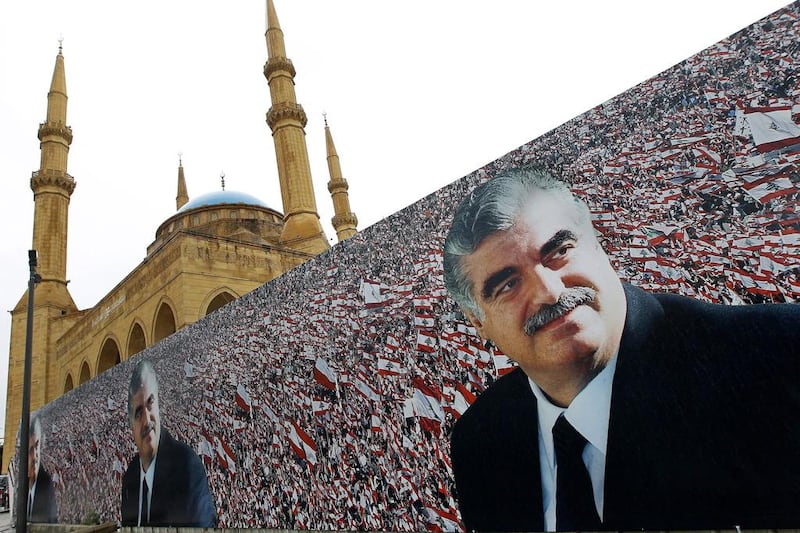BEIRUT // It was almost 1pm on Valentine’s Day ten years ago.
In the back of a taxi, on the way to a lunch with my cousins in the Lebanese capital, I was preoccupied with the long stemmed rose I had received from a secret admirer earlier in the day.
I had only recently moved to Lebanon from Iraq where I had documented life in the country post-Saddam.
Little did I know that my experience there was about to prove useful.
We were driving along Beirut’s seafront Corniche road when suddenly I heard an enormous “thud” and the taxi, an old beat-up Mercedes, violently shook as if hit by an earthquake.
I knew from my time in Iraq that this sound could only mean one thing: An explosion.
Looking ahead, I saw a huge cloud of black smoke rising in the distance. It wasn’t far, and so I got out of the car and ran towards it.
The smell of ash and melted metal increased as I got closer to the scene of the bombing, in front of the St George Hotel.
Rows of gutted, deformed cars littered the area. Glass, wood and metal debris were scattered all over the road and pavement. The facades of surrounding buildings had been ripped away, and wires bulged out of them, accompanied by the hissing sound of shorting circuitry.
I saw people with blood on their faces, shouting in pain and lying among the carnage.
There were screams, someone was on fire, and there were sounds of groans under a pile of twisted metal and bricks.
I ran to the edge of what looked like a meteorite crater, writing down everything that I saw. I had seen similar craters dozens of times before in Iraq after bombings. But nothing as big or as deep as this one.
Amid all this confusion, there, at the far edge of the crater, was a body. It looked smaller than normal. That’s because bodies shrink when burned.
I would later learn that this body belonged to the man who had been characterised by the media as the larger-than-life former prime minister, Rafik Hariri.
A decade has passed since that afternoon when Lebanon’s former leader was assassinated in a suicide truck bombing, and the question of who killed him, along with 21 others, remains unanswered.
While the crowds have dwindled over time, mourners still visit Hariri’s memorial on a daily basis. The void left by the death of this charismatic businessman and politician, credited with rebuilding and revitalising a post-civil war Lebanon, has yet to be filled.
Hariri lies buried next to those who died with him in the blast, near the blue-domed Mohammed Al Amin mosque that he started to build in 2002 in the capital’s downtown area. His son, Saad, inaugurated it in October 2008.
Hundreds of millions of dollars have been spent on the UN-backed Special Tribunal for Lebanon, or the “Hariri Tribunal” as it is better known, while dozens of international investigators and judges have been involved in trying to find those responsible for the Sunni politician’s death. Meanwhile, endless conspiracy theories blaming parties that range from Israel and Syria to Iran and the United States, as well as individuals inside Lebanon itself, continue to be discussed among the Lebanese as so far nothing concrete has come out of the investigations and justice is yet to be delivered.
With initial suspects in the case now dismissed — including Palestinian Ahmad Abu Adas, who falsely claimed responsibility for the attack shortly after it happened — the tribunal is now trying in absentia five members of Hizbollah. Recent developments also point to possible Syrian complicity, a revelation that is sure to drag Lebanon further into violence and discord.
What has remained a constant and vital part of the story throughout, however, is the Mitsubishi truck that carried the explosive. Stolen in Japan, it was then shipped to the UAE and later bought in Tripoli, Lebanon before making its way to Beirut.
Hariri’s death sent tremors across the Middle East, leading to the so-called Cedar Revolution, a series of protests that resulted in the withdrawal of Syrian troops from Lebanon. Subsequent assassinations, bombings and terrorist threats have continued to rock the fragile state, which — just over a year after Hariri’s death — was plunged into another war with Israel in the summer of 2006, and today remains perpetually on the verge of conflict.
A decade on, I still remember how, as I emptied my handbag at the end of that long and emotional day, I found my now crumpled rose.
I recall thinking how symbolic this rose was of that date in history; of how Valentine’s Day in Lebanon will always have a sorrowful undertone of lost love. And still today, on the 10th anniversary of his death, the Lebanese insist they will never forget their former prime minister.
“Ten, one hundred, one thousand years,” read banners hung along the streets of Beirut. “We will continue.”
rghazal@thenational.ae
Rym Ghazal is a senior features writer and columnist at The National.





